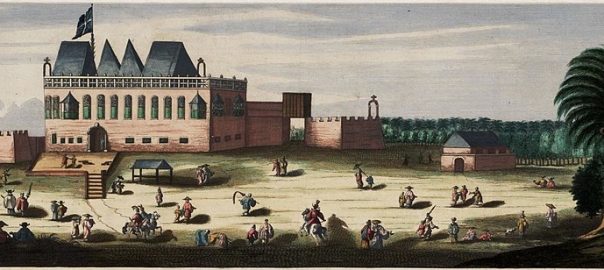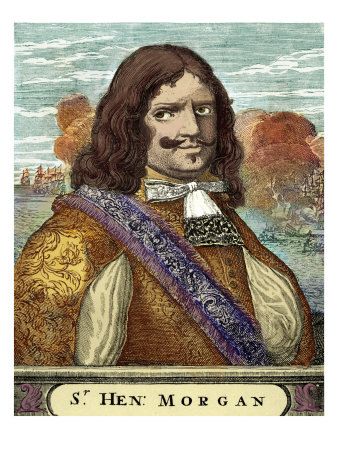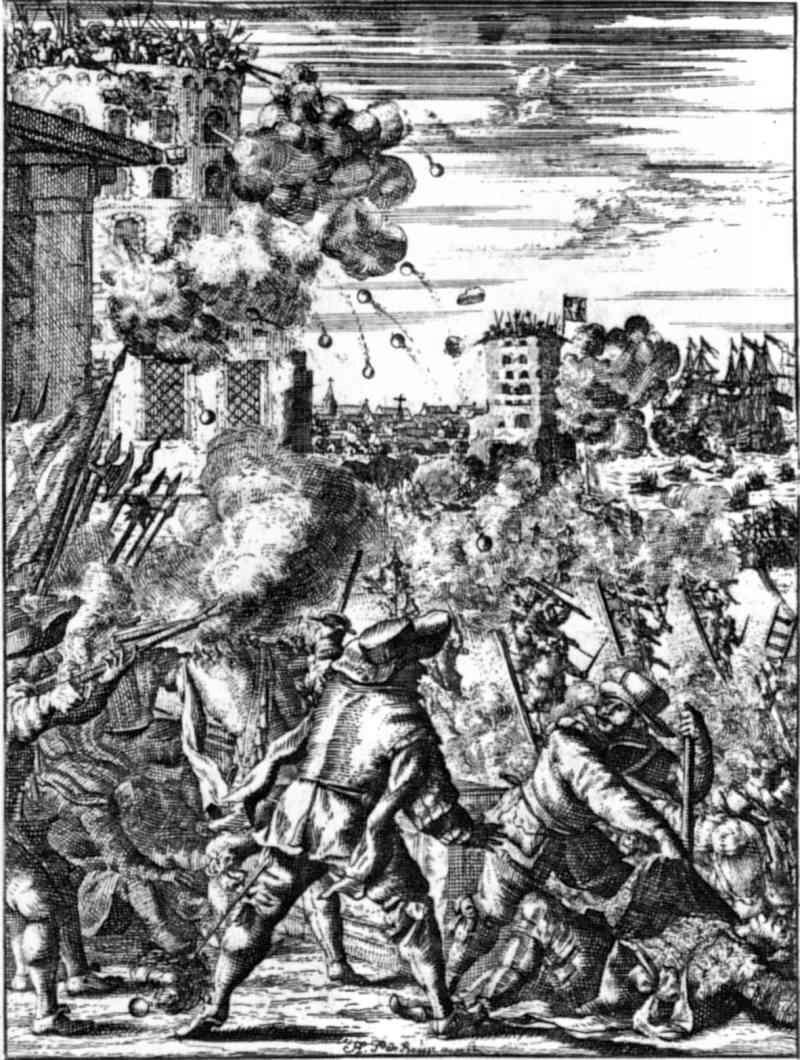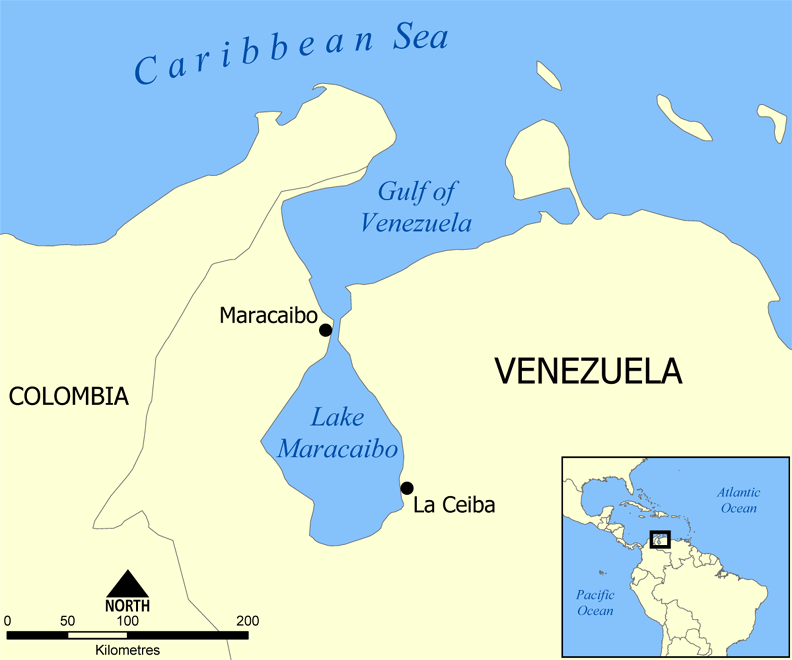In 1668 CE, relations in Europe among the four world-imperial powers– or now, about to be five, with the addition of France– continued to be complex with alliances and hostilities among them continually shifting. Spain was still in a long-term decline, which left several of its colonies in the Caribbean fairly vulnerable. Today I’ll look in some detail at the career of a colorful Welsh pirate, Henry Morgan: In 1668, operating out of Jamaica with the backing of its English governor, Morgan launched a number of bold and very profitable raids on Spanish positions in Cuba, Panama, and Venezuela. He plowed many of the profits from these raids into buying slave-labored plantations in Jamaica, and I’ll look a little at those, too.

But Spain was not totally out for the count. In 1668, it finalized the arrangement that ended its lengthy attempt to reverse the independence of Portugal, and as part of that settlement Portugal handed over to it control of the enclave of Ceuta in northern Morocco– which it has retained until today.
And in other colonial news from 1668, in March England’s King Charles II granted a charter to the East India Company to establish a long-term trading fort on the islands of Bombay that had originally come to the British Crown in 1661 as part of the dowry of his Portuguese wife, Catherine of Braganza. (W. Dalrymple in his history of the EIC’s early years, The Anarchy, p.22, noted that when the English first received the list of the Portuguese princess’s dowry they had no idea where “Bumbye” was; and the Lord High Chancellor opined that he thought it was “somewhere near Brazil”…)
Above, see a view of the English fort in Bombay, c. 1665.
Welsh pirate Henry Morgan, acting for England, goes on a plundering rampage in the Caribbean
Henry Morgan was a Welshman, of probably a pretty humble background, who had most likely worked with several English plundering raids against the Spanish in the Caribbean prior to 1668. But in 1668, his exploits became very widely known. The account Wikipedia gives of his exploits that year make it abundantly clear that English policy in much of the Atlantic was still based– as it had been since the Elizabethan era 100 years and more before– on official support for forms of piracy and plundering that, while they might have had some slight degree of “deniability” from the authorities, nonetheless still served as a rich form of revenue for those self-same authorities.
Here’s WP’s account of the background to Morgan’s exploits:
In 1667 diplomatic relations between the kingdoms of England and Spain were worsening, and rumours began to circulate in Jamaica about a possible Spanish invasion. [Jamaican governor] Modyford authorised privateers to take action against the Spanish, and issued a letter of marque to Morgan “to draw together the English privateers and take prisoners of the Spanish nation, whereby he might inform of the intention of that enemy to attack Jamaica, of which I have frequent and strong advice”. He was given the rank of admiral and, in January 1668, assembled 10 ships and 500 men for the task; he was subsequently joined by 2 more ships and 200 men from [French-ruled] Tortuga (now part of Haiti).
A “Letter of marque” was basically a special kind of license that authorities– in this case, Governor Modyford– would give to pirates that authorized them to seize on the high seas ships and their contents flying the flag of some other country… and to do so on the basis of some prior, never specified (and frequently quite imaginary) damage that the other country had inflicted on the authority that issued the letter. This system was well described in David Childs’ book Pirate Nation: Elizabeth I and her Royal Sea Rovers.
The WP account continues:
Morgan’s letter of marque gave him permission to attack Spanish ships at sea; there was no permission for attacks on land. Any plunder obtained from the attacks would be split between the government and the owners of the ships rented by the privateers. If the privateers stepped outside their official remit and raided a city, any resultant plunder would be retained by the privateers. [Jan] Rogoziński observes that “attacks on cities were illegal piracy—but extremely profitable”, although [Nuala] Zahedieh records that if Morgan was able to provide evidence of a potential Spanish attack, the attacks on cities were justifiable under the terms of his commission.
Morgan’s initial plan was to attack Havana, but, on discovering it was heavily defended, this was changed to Puerto Principe (now Camagüey), a town 50 miles (80 km) inland [in Cuba]. Morgan and his men took the town, but the treasure obtained was less than hoped for…
After dividing the spoils of the conquest of Puerto Principe, Morgan announced a plan to attack Porto Bello (now in modern-day Panama). The city was the third largest and strongest on the Spanish Main, and on one of the main routes of trade between the Spanish territories and Spain. Because of the value of the goods passing through its port, Porto Bello was protected by two castles in the harbour and another in the town. The 200 French privateers, unhappy with the division of the treasure and the murder of their countryman, left Morgan’s service and returned to Tortuga. Morgan and his ships briefly landed at Port Royal before leaving for Porto Bello.
Worth recalling here that Panama, and most likely it’s Caribbean-side port at Porto Bello, was a key trans-shipment point for plundered goods that the Spanish wanted to bring back back to Spain from the silver-mines of Peru, the saltpetre mines of Chile– and also from the Philippines, since they could not now bring them back via the Indian Ocean – Cape of Good Hope route.
More from WP:
On 11 July 1668 Morgan anchored short of Porto Bello and transferred his men to 23 canoes, which they paddled to within three miles (4.8 km) of the target. They landed and approached the first castle from the landward side, where they arrived half an hour before dawn. They took the three castles and the town quickly. The privateers lost 18 men, with a further 32 wounded; Zahedieh considers the action at Porto Bello displayed a “clever cunning and expert timing which marked … [Morgan’s] brilliance as a military commander”.

There were allegations, that he disputed, that to mount the walls of one of the castles, he constructed broad ladders and then forced Spanish monks and nuns he had previously captured to carry those to the walls…
Morgan and his men remained in Porto Bello for a month. He wrote to Don Agustín, the acting president of Panama, to demand a ransom for the city of 350,000 pesos. As they stripped the city of its wealth it is probable that torture was used on the residents to uncover hidden caches of money and jewels. Zahedieh records that there were no first-hand reports from witnesses that confirmed Exquemelin’s claim of widespread rape and debauchery. After an attempt by Don Agustín to recapture the city by force – his army of 800 soldiers was repelled by the privateers – he negotiated a ransom of 100,000 pesos. Following the ransom and the plunder of the city, Morgan returned to Port Royal, with between £70,000 and £100,000 of money and valuables; Zahedieh reports that the figures were more than the agricultural output of Jamaica, and nearly half Barbados’s sugar exports. Each privateer received £120 – equivalent to five or six times the average annual earnings of a sailor of the time. Morgan received a five per cent share for his work; Modyford received a ten per cent share, which was the price of Morgan’s letter of marque. As Morgan had overstepped the limits of his commission, Modyford reported back to London that he had “reproved” him for his actions although, Zahedieh observes, in Britain “Morgan was widely viewed as a national hero and neither he nor Modyford were rebuked for their actions”.
In October 1668, Morgan took another flotilla off for another raid. This one took him to the Spanish forts at Maracaibo and La Ceiba (now Gibraltar), on the northern coast of Venezuela. Once again, he showed great tactical cunning– which is worth reading about– bringing back to Jamaica a take totaling “250,000 pesos, and a huge quantity of merchandise and a number of local slaves.”
At that point, the capital of Jamaica was still in Port Royal, though that settler-city was destroyed in an earthquake in 1692. WP tells us this about Morgan’s return on this second occasion:
During his absence from Port Royal, a pro-Spanish faction had gained the ear of King Charles II, and English foreign policy had changed accordingly. Modyford admonished Morgan for his action, which had gone beyond his commission, and revoked the letters of marque; no official action was taken against any of the privateers. Morgan invested a share of his prize money in an 836-acre (338 ha) plantation – his second such investment.
Well, Charles II may have wanted to calm things down with the Spanish but the Spanish Regent, Queen Mariana, was not so inclined; and in 1669, she ordered (reprisal) attacks on English shipping in the Caribbean. So then, this:
The first [Spanish] action took place in March 1670 when Spanish privateers attacked English trade ships. In response Modyford commissioned Morgan “to do and perform all manner of exploits, which may tend to the preservation and quiet of this island”. By December Morgan was sailing toward the Spanish Main with a fleet of over 30 English and French ships carrying a large number of privateers. Zahedieh observes that the army of privateers was the largest that had gathered in the Caribbean at the time, which was “a mark of Morgan’s renown”…
… And so it carried on. In 1671, Morgan’s massive raiding party burned down the whole of Panama City… I think I’ll leave this account of his exploits there but just note that (1) though he was formally reprimanded by Charles II who ordered his arrest, he was probably never arrested but was treated as a hero throughout London; (2) shortly thereafter he was knighted by the king; and (3) he returned to Jamaica and was made deputy governor.
And about those plantations that he amassed with his plundered pirate-booty? WP tells us this:
In the 1670s and 1680s, in his capacity as an owner of three large slave plantations, Morgan led three campaigns against the Jamaican Maroons of Juan de Serras. Morgan achieved some success against the Maroons, who withdrew further into the Blue Mountains, where they were able to stay out of the reach of Morgan and his forces. However, Morgan failed in his attempts to either capture de Serras or to subdue his community of runaway slaves.
By the time Morgan died, he owned three plantations and large numbers of African slaves. He left most of his estate to his wife for the rest of her life. On her death, most of his land and slaves passed to his nephew Charles…
Morgan’s will was probated in 1689, and at his death he owned 131 African slaves on his estates, of which 64 were male and 67 female. About 33 of these slaves were listed as boys, girls or children. The slaves were valued at £1,923.




